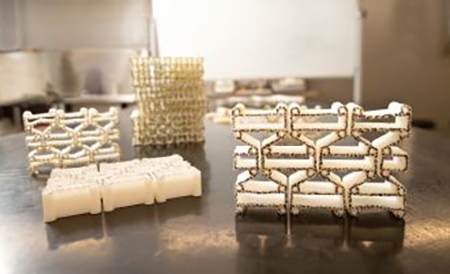| Oct 18, 2021 |
Running shoe material inspired 3D-printed design to protect buildings from impact damage
|
|
(Nanowerk News) A material used in running shoes and memory foam pillows has inspired the design of a 3D-printed product that could help protect buildings from collision damage and other high impact forces, equivalent to a car travelling at 60km/hr.
|
|
Published in Smart Materials and Structures ("Behaviour of 3D Printed Re-entrant Chiral Auxetic (RCA) Geometries under In-Plane and Out-of-Plane Loadings"), Dr Tatheer Zahra from the QUT Centre for Materials Science and QUT School of Civil and Environmental Engineering used off-the-shelf bioplastic to 3D print geometric shapes that mimic the behaviour of auxetic materials.
|
 |
| Examples of 3D-printed auxetic geometries. (Image: QUT)
|
|
“Rather than flattening when stretched or bulging when compressed, auxetic materials expand or contract in all directions at once, which makes them highly energy-absorbent and load resistant,” Dr Zahra said.
|
|
“But existing commercial auxetic material is expensive and not locally available, so I designed geometric shapes that achieved the same behaviour.”
|
|
Dr Zahra said 3D printing auxetic geometries could potentially replace steel and fibre reinforced polymer mesh reinforcements in composites, and could also be used as a flexible and widely applicable protective wall render.
|
|
She said the energy absorption would be equivalent to a 20mm thick reinforced composite protective render over a full-scale building wall, which could potentially withstand the impact force of a car travelling at 60km/h.
|
|
“At scale, composites embedded with these geometries could theoretically resist high impact or shock energy caused by gas explosions, earthquakes and wind forces, and car collisions.
|
|
“In Australia, there’s an estimated 2000 vehicular crashes each year. Direct building damage cost at 2.5 per cent would put the damage bill at about $38.65M/year for housing.
|
|
“Since vehicles also crash into apartments, office building, restaurants and convenience stores, this cost of building damage would probably be higher.
|
|
“Loss of life would be the highest cost.”
|
|
Dr Zahra said protection for masonry walls was especially important because it was an essential part of most commercial and residential buildings.
|
|
“Masonry is a very cheap material that is resilient to noise, heat, and has better fire protection properties compared to wood or steel, but its mortar joints weaken the overall structural strength.
|
|
“If auxetic geometries were embedded into the mortar to make protective composites, they would also be protected from microorganisms and temperatures over 60°C, and should last the design life of the structure,” she said.
|
|
Proven at lab scale, Dr Zahra now aims to test the designs on full scale masonry and concrete structures at the QUT Banyo Pilot Plant.
|
|
"The designs would be good prospects for commercialisation through additive manufacturing because the production process is flexible and materials are readily available,” Dr Zahra said.
|
|
“3D printing would also allow us to change the material, size or design of geometric shapes to suit different structures and load requirements.”
|
|
Dr Zahra said bioplastics provided a more sustainable, low carbon emission alternative to fibre-reinforced plastic or other non-biodegradable polymers.
|
|
She said it was also more cost effective than using available auxetic fabrics, which could cost up to $400 per square metre and were not biodegradable.
|

